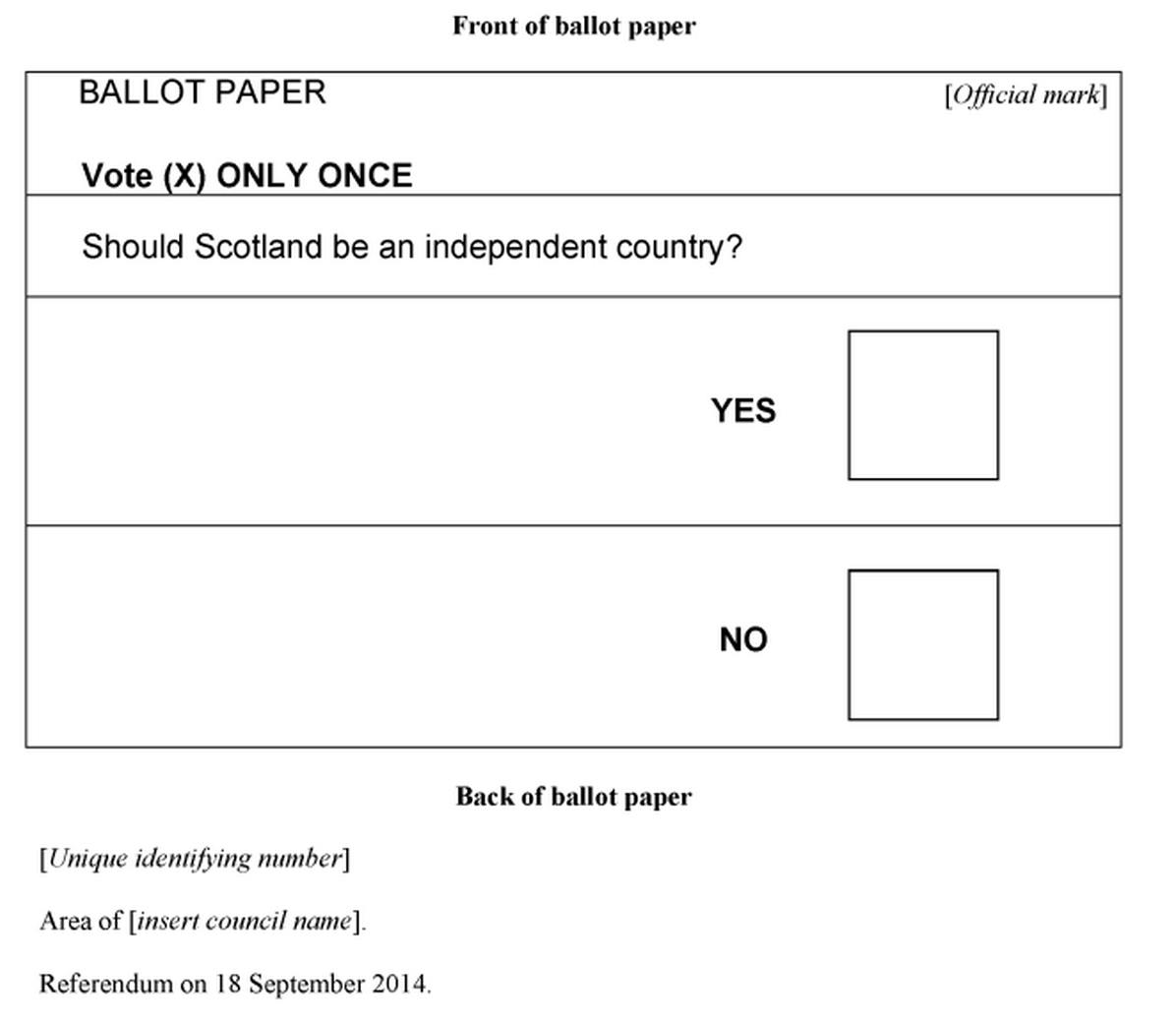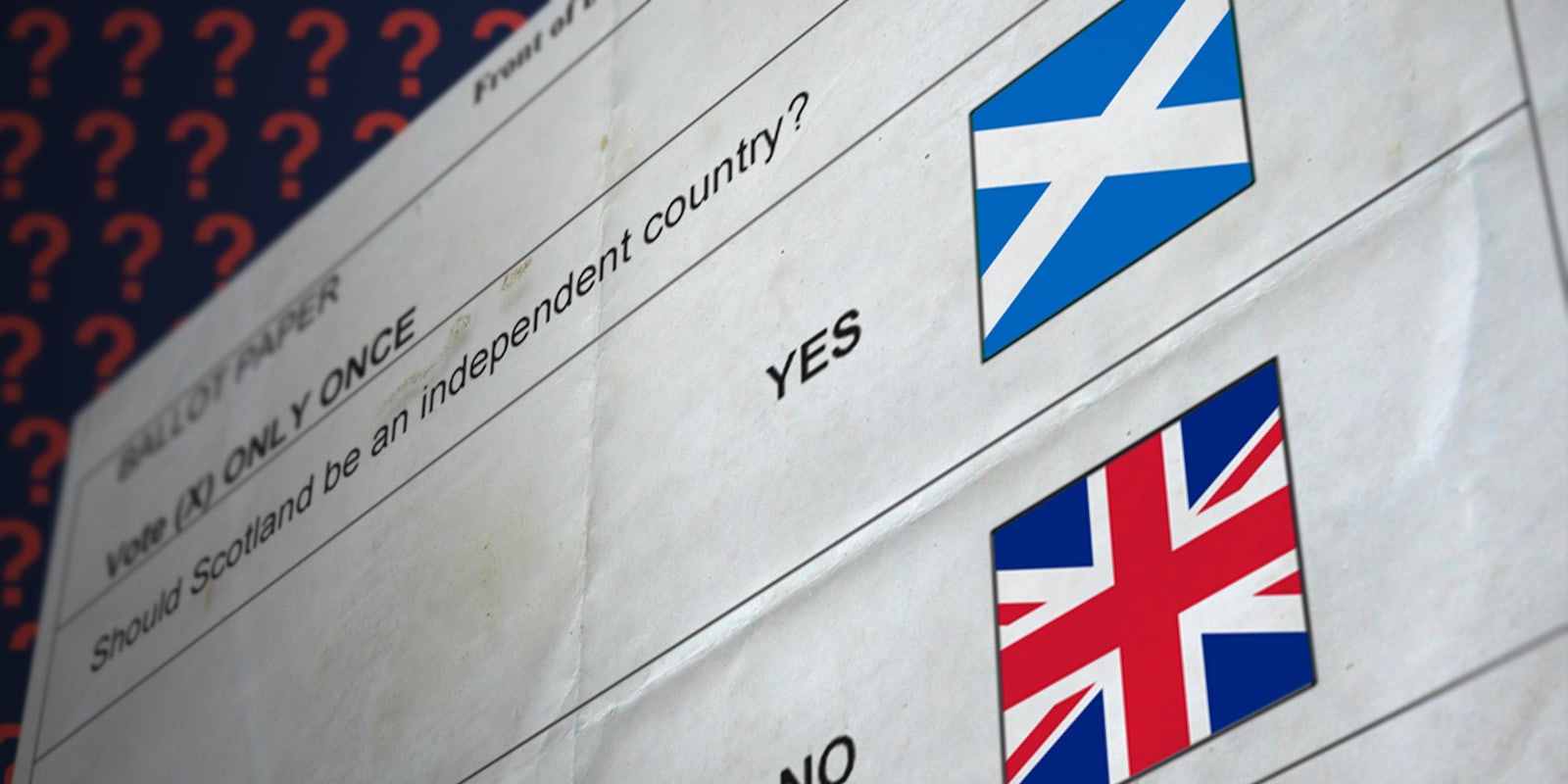Today, Scotland goes to the polls, and will either emerge on Friday morning, covered in blue and white paint while crying “Freedom!”, as the world’s newest born country… or simply remain part of the United Kingdom. In other words, this vote could make history, or simply preserve what has been for hundreds of years. Given the importance of the vote, and the complicated politics surrounding it, we’ve put together a simple guide to help you navigate the political maze.
The basics
Scotland is a country within the United Kingdom, alongside England, Wales, and Northern Ireland. On Thursday, every registered voter in Scotland will have the chance to decide if they want to break away from the U.K. and be their own independent nation.
Currently, much of Scotland’s domestic policy is devolved to Scotland alone. But certain issues, like foreign affairs and defence, are retained by the U.K. Parliament. Helpfully, well known YouTube explainer CGP Grey put together a video explaining the ins and outs of the United Kingdom. It’s a little confusing.
For a more indepth look into the politics behind the Scottish independence referendum, the Daily Dot has composed a guide.
The vote
So, when does the action kick off? The polls open at 7am BST (British Summer Time)—that’s 2am EST, 1am CST or 11pm PDT. They remain open for 13 hours, until 10pm at night in the U.K. (5pm EST, 4pm CST, 2pm PDT).
The voting is done on paper and results are manually counted by volunteers through the night. Voting areas are split into Scotland’s 32 local authorities, and each will count individually, before they are all tallied together. The ballot will simply ask, “Should Scotland be an independent country?”

There are no exit polls, meaning the results won’t be immediately apparent: You’ll have to wait until the ballots are formally counted. Luckily, this won’t take long—the results of all 32 local authority regions hope to be declared by 7am BST Friday morning (2am EST, 1am CST, 11pm PDT). If the vote is especially close, however, it could be later.
The regional results won’t come in uniformly either; the earliest are expected at 2am BST Friday (9pm EST, 8pm CST, 6pm PDT Thursday), and they’ll continue to trickle through half-hourly from there until 6am (1am EST, 12am CST, 10pm PDT)—barring any irregularities or recounts.
Here’s the full timetable:
Reminder: These are the times Scottish regions are expected to declare their results on Thursday night #IndyRef pic.twitter.com/5yem9LN2zk
— Rob Price (@robaeprice) September 17, 2014
Who can vote?
Anyone resident in Scotland over the age of 16. According to surveys, more than 97 percent of those eligible have registered to vote, so the referendum could have the highest turnout in British electoral history, and the result will likely come down to the undecided voters.
Where the issue stands
It’s currently neck and neck, with the latest polls on Wednesday showing a 51-to-49 percent advantage to the ‘No’ camp—those who want to Scotland to stay in the U.K.—but it is within the margin of error. Until recently, the No vote was well ahead, but in the past few weeks it has come close, and at one point the Yes vote led the polls for the first time.
Who to follow
Much of U.K. media is running live blogs on the referendum, which will update automatically and provide up-to-the-minute results and analysis. This includes the BBC, the Daily Telegraph, the Daily Mirror and the Guardian. Another big player will be the well-connected British political blog Guido Fawkes, which will likely add a humorous twist alongside gossip to Thursday’s polls.
There are also numerous journalists and public figures to follow on Twitter who are in Scotland currently.
• Rob Price, Politics reporter at the Daily Dot: @robaeprice and @DotPolitics
• Harry Cole, News Editor of Guido Fawkes: Will be taking part in CNN’s live referendum show tomorrow night: @harrycole
• Tim Stanley, Blogger for the Daily Telegraph: @timothy_stanley
• Jim Waterson, Deputy Editor of Buzzfeed U.K.: Currently camped in Glasgow to find the 32 most creative insults from Yes voters on Twitter. – @jimwaterson
• Tomas Hirst, Political Reporter for Business Insider: – @thomashirstecon
• Ari Shapiro, NPR’s International Correspondent in London: Tweets Scottish delicacies he eats on the trail of the referendum: @arishapiro
• Siraj Datoo, Political Reporter for Buzzfeed U.K.:. Has found many of the interesting stories behind the news, including people getting ‘Yes’ tattoos for £2: @sirajdatoo
• J.K. Rowling, author of Harry Potter: The best-selling novelist is one of the most high-profile and passionate defenders of the Union. As she said in a recent tweet, “my head says no and my heart shouts it—but whatever happens, I hope we’re all friends by Saturday.”: @jk_rowling
• David Cameron, British Prime Minister, Leader of the Conservative Party (and notoriously bad tweeter): Is in favour of a No vote on Thursday: @David_Cameron
• Alex Salmond, Scottish First Minister and Leader of the Scottish National Party: The man behind the referendum. He believes Scotland should vote Yes. He came under fire recently for pressuring a university chancellor to help push the ‘Yes’ agenda: @AlexSalmond
• Alistair Darling, former Chancellor and chair of the “Better Together” campaign: More famous for his eyebrows than his tweets, but well worth a follow: @TogetherDarling
How and where you can watch it all unfold
Many U.S. news channels will be running specials on the vote, including CNN, which will be broadcasting from Scotland. You can also watch the BBC’s live coverage if you are in the U.K., or by using a VPN if you’re not.
It is likely much of the news before the polls close will be of little substance, with the real results coming in throughout the night, which many people in Britain will be staying up to watch.
What happens if they vote ‘Yes’
Should Scotland vote ‘Yes’ tomorrow, the Scottish government hopes to formally become independent on March 24th, 2016. This could only happen by then, however, if all the negotiations over issues have been completed. This includes the divvying up of oil and gas in the North Sea, and the assignment of Scotland’s share of the debt currently held by the U.K.
Scotland also needs to approach organizations such as the UN, the EU and NATO to discuss membership, which is not automatic. This is also coupled with a difficult debate the country is having over currency, with Alex Salmond claiming he can continue using the pound sterling—speculation David Cameron disagrees with.
There is also the formality of approving the referendum. The British Parliament in London must hold a vote to repeal the 1707 Act of Union that will actually allow Scotland to become independent—without approval the vote is moot. It would be unprecedented for the British Parliament to disagree with the result, but again it is not automatic. The Queen would then have to sign it into law. On that note, Salmond has indicated he wishes to keep Queen Elizabeth II on the throne of Scotland in a similar way to Canada.
There are also ongoing debates of how a border between the two independent countries would be administered.
What happens if it’s a draw
No one knows, basically. As the BBC points out, the Scottish Independence Referendum Act 2013, which laid the legal groundwork for the vote, is “about 60,000 words long, but, as the Electoral Commission acknowledges, it makes no reference to a dead heat.”
Additional reporting by Rob Price.
Ballot image via Legislation.gov.uk | Photo via (Britt) / Wikimedia Commons (CC BY 2.0) | Remix by Rob Price


